The global food container market is estimated to be valued at USD 180.08 Bn in 2025 and is expected to reach USD 245.23 Bn by 2032, growing at a compound annual growth rate (CAGR) of 4.5% from 2025 to 2032.
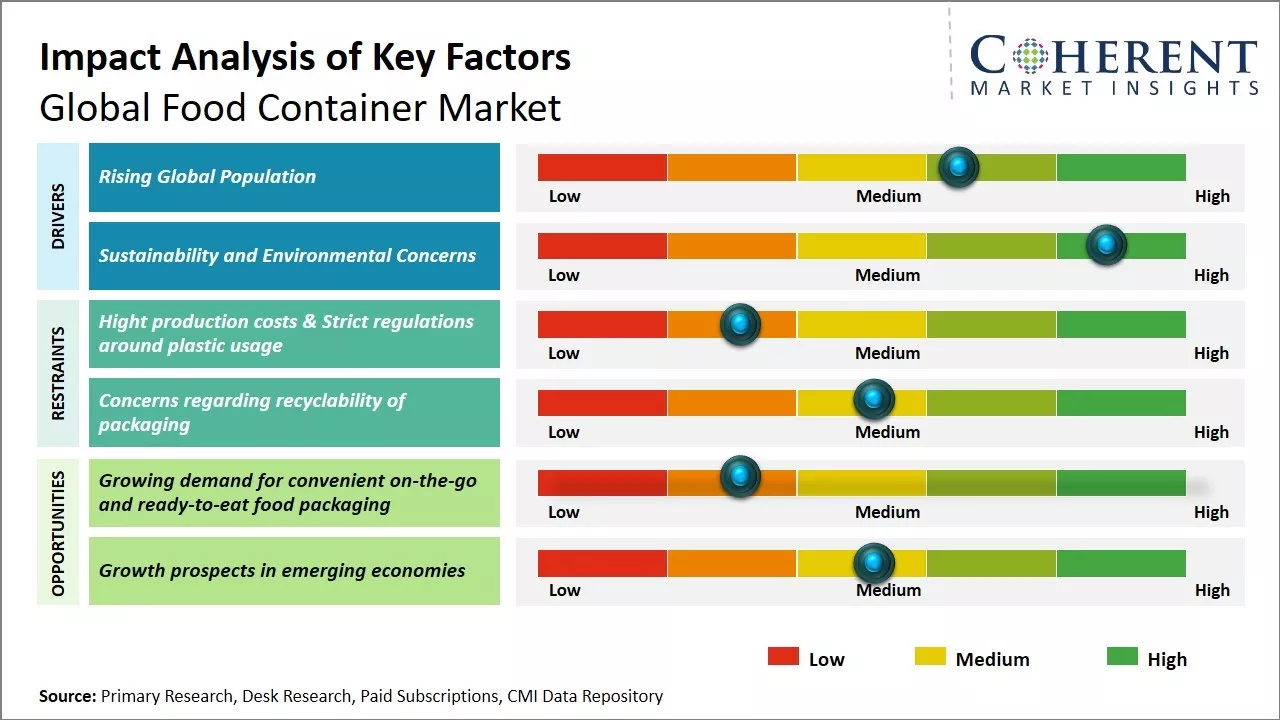
Discover market dynamics shaping the industry: Download Free Sample
The rising demand for convenience food packages among busy consumers is driving the demand for innovative food containers. Rapid urbanization and changing consumer lifestyle have increased the demand for ready-to-eat meals and packaged food products. This has compelled manufacturers to focus on developing innovative packaging solutions, suitable for various food applications. Growing focus on sustainable packaging along with increased spending on R&D activities by major players are expected to offer new growth opportunities for the market in the coming years.
Rising Global Population
The ever increasing global population has become one of the major drivers for the growth of the global food container market in recent years. As per various estimates, the world population has grown exponentially over the past few decades and is expected to reach around 9 billion by 2050. With more mouths to feed every year, the demand for food production is rising dramatically across both developed and developing regions of the world. This surge in population naturally translates to a higher demand for food packaging and containers of various types used in the food production, storage, transportation, and retail sectors. Developing countries in Asia Pacific, Africa, and Latin America are experiencing the most rapid population growth rates which is putting tremendous strain on their existing food supply infrastructure. These regions are forced to ramp up domestic food production at an unprecedented scale to sustain their teeming populations. This has provided huge impetus to the food container industry as more packaging solutions are needed for packing, preserving, and transporting farm produce, staple food items, and processed food over long distances within countries and even globally.
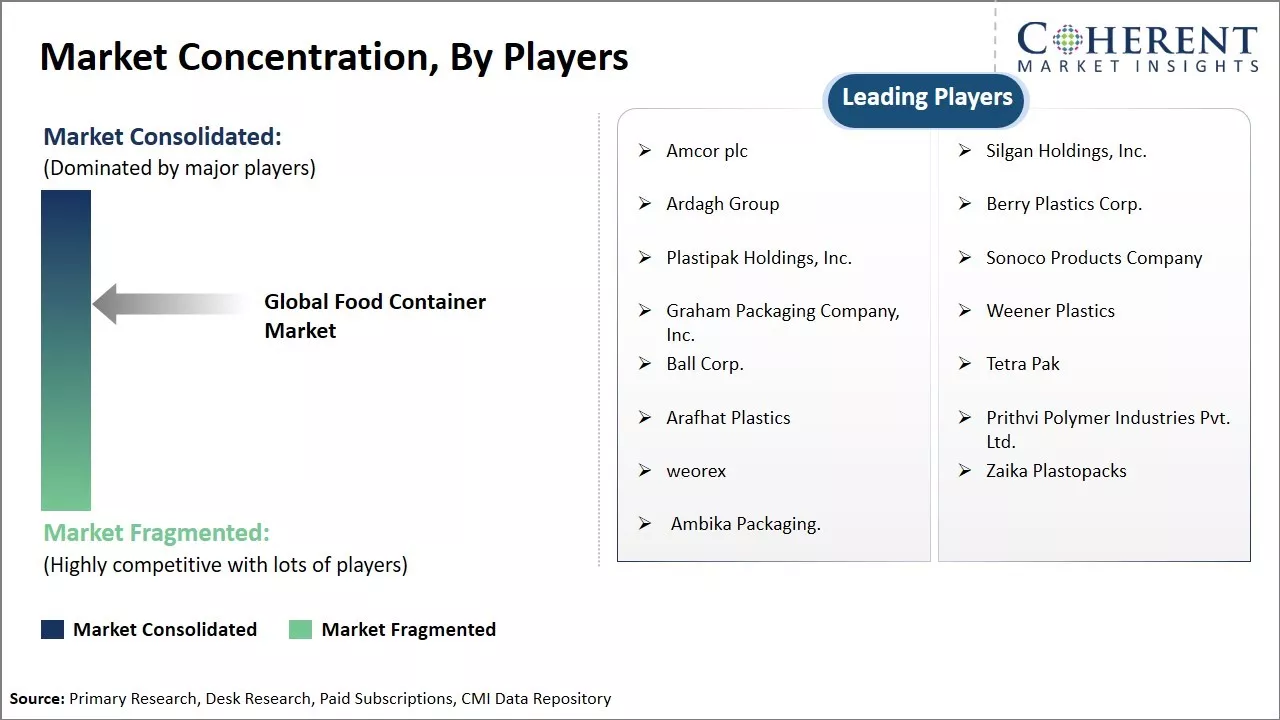
Get actionable strategies to beat competition: Download Free Sample
Sustainability and Environmental ConcernsAnother important driver behind the rising global demand for advanced food containers has been the growing focus on sustainability and environmental protection globally in recent years. Plastic food packaging, while cheap and convenient, has come under increasing criticism due to widespread pollution issues caused by single use plastics that are difficult to recycle. Both public awareness as well as government policies worldwide are driving manufacturers, retailers, and consumers towards exploring more sustainable food packaging options. In response, food container manufacturers are innovating novel designs using alternative materials like bioplastics, aluminum, glass, cardboard, and compressed corrugated paper that offer lower environmental impact compared to plastics. Features like improved recyclability, compostability, and reuse capability are in higher demand now. Furthermore, the deployment of advanced processing technologies allow the development of thinner and lightweight packaging films with equivalent barrier properties, reducing overall material usage. Companies promoting recyclable and reusable food containers through deposit return schemes are also gaining favor. Such sustainable packaging helps companies bolster their green and socially responsible credentials to environment conscious customers globally. While initial costs may be higher, the long term sustainability benefits are boosting the broader market segment for ecofriendly food containers.
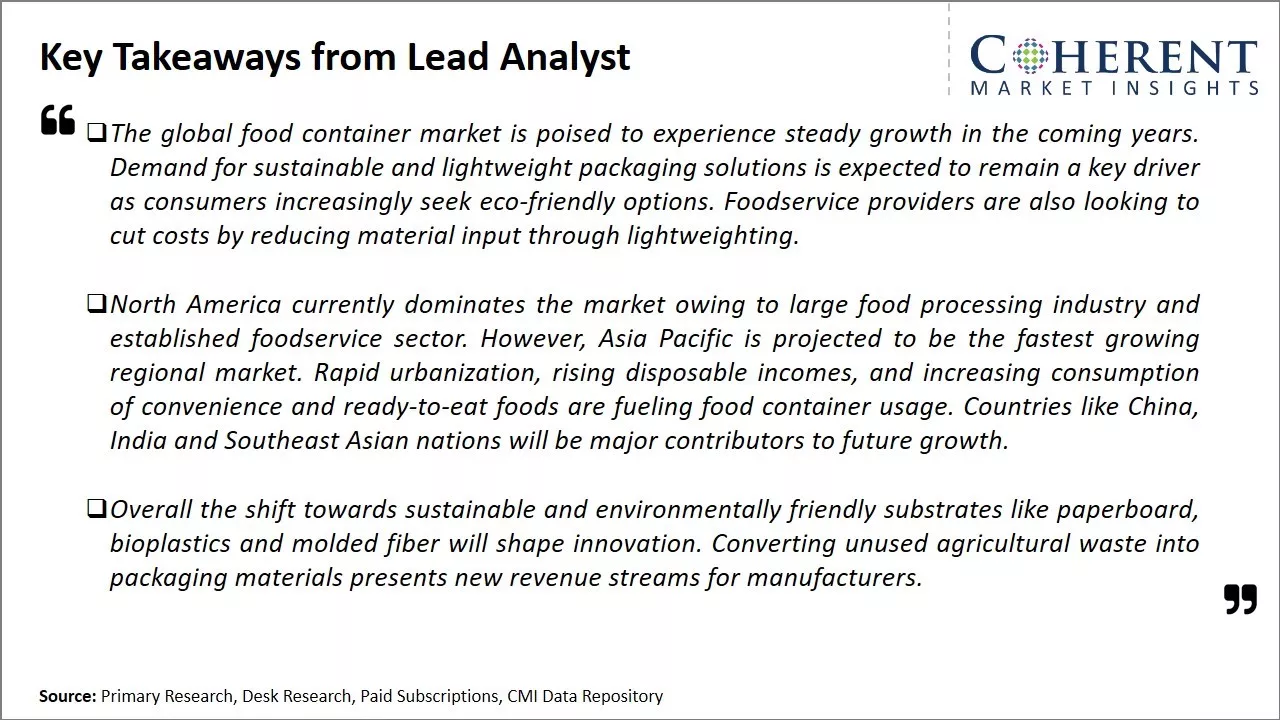
To learn more about this report, Download Free Sample
Challenges: High production costs & strict regulations around plastic usageProduction costs are rising due to increasing raw material prices. Strict regulations around plastic usage and bans on single-use plastic items present compliance issues. Additionally, consumer preferences are shifting towards more sustainable packaging options. Supply chain disruptions from the pandemic have constrained suppliers. Changes in consumption patterns outside foodservice have also impacted demand. Technological advancements are needed to develop competitive alternative materials. Environmental concerns around plastic waste require container designers to optimize for recyclability and renewability.
Opportunities: Growing demand for convenient on-the-go and ready-to-eat food packaging
The demand for convenient on-the-go and ready-to-eat food packaging continues to surge. The growth of e-commerce grocery and meal delivery services require packaging tailored for online orders and transportation. The popularity of international cuisines and variations in eating habits across regions provide chances to tailor products for local tastes.
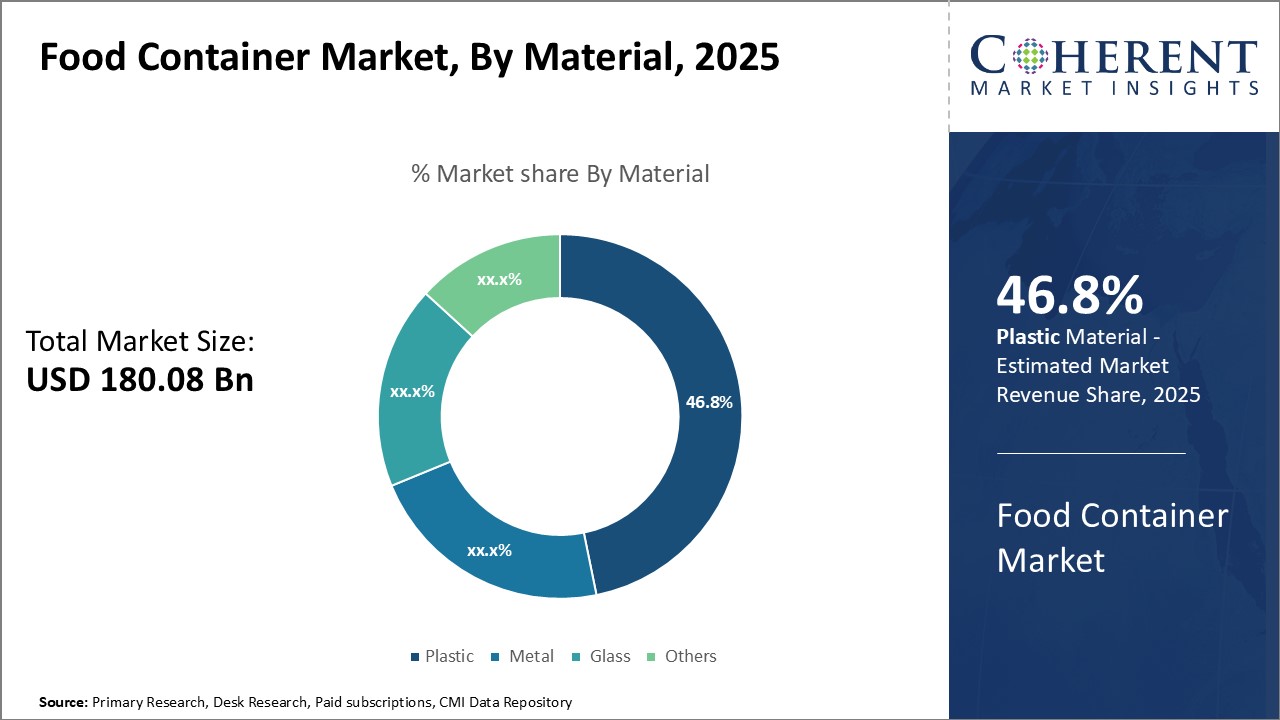
Discover high revenue pocket segments and roadmap to it: Download Free Sample
Insight by material: In terms of material, plastic contributes the highest share of the market owing to its versatility and cost effectivenessThe plastic segment currently dominates the global food container market in terms of material. Plastic accounts for over 46.8% of the total market share due to its versatility and cost effectiveness compared to other materials in 2025. Plastic is lightweight and takes on various shapes and sizes with ease during production. This allows plastic food containers to be tailored according to the specific needs of different food products. Their flexibility in design helps protect foods effectively while also enabling easy handling and storage. Plastic also resists corrosion and is durable for multiple uses. This amplifies their value proposition for both food manufacturers and consumers. The cost advantage of plastics further boosts their popularity. Plastic food containers can be mass produced at lower unit costs than other materials. Their production requires less energy and raw materials compared to metals or glass. This price competitiveness allows businesses to offer plastic food containers at affordable prices. It also makes plastic options feasible for packaging a wide range of foods, including those consumed by the masses on daily basis. Growing environmental concerns, however, could impact plastic usage over the long run. Regulations against single-use plastics are tightening in many regions to reduce plastic waste. Environmental-friendly alternatives may gain more traction if they can match plastics' versatility and low costs. Still, plastic food containers are well-positioned to retain dominance in the foreseeable future backed by strong value, widespread use, and ability to integrate more recycled content.
Insights by product: Among the segments, cans contribute the highest share of the market owing to their suitability for liquids and foods requiring preservatives
Metal cans dominate the market for food container products. Within the product segment, cans account for 36.1% of the market share owing to their ideal characteristics for the preservation of foods that contain liquids or require artificial preservatives during long shelf-life in 2025. Cans provide excellent barrier protection against air, moisture, light, and microorganisms for food and beverage filling. This barrier capability is derived from can packaging material which is normally composed of thin aluminum/steel. Due to their impermeable structure, cans allow extension of shelf-life for months after processing without deterioration in product taste, quality, and nutrition. The preservative-free sealing maintains freshness and safety of packaged contents. It allows distribution and storage of canned foods and beverages anywhere without addition of chemical preservatives otherwise needed in non-hermetic packaging. This natural preservative attribute satisfies growing consumer preference for clean label and minimally processed products. Cans are also efficient in resources since they optimize every bit of the packaging material to seal fillings hermetically. The shape accommodates maximum quantity of filler to packaging material weight ratio. This efficient usage along with unlimited shelf-life benefits provided by cans expands their use across vast array of liquid foods including fishes, seafood, meat, ready meals, soups, beverages, etc.
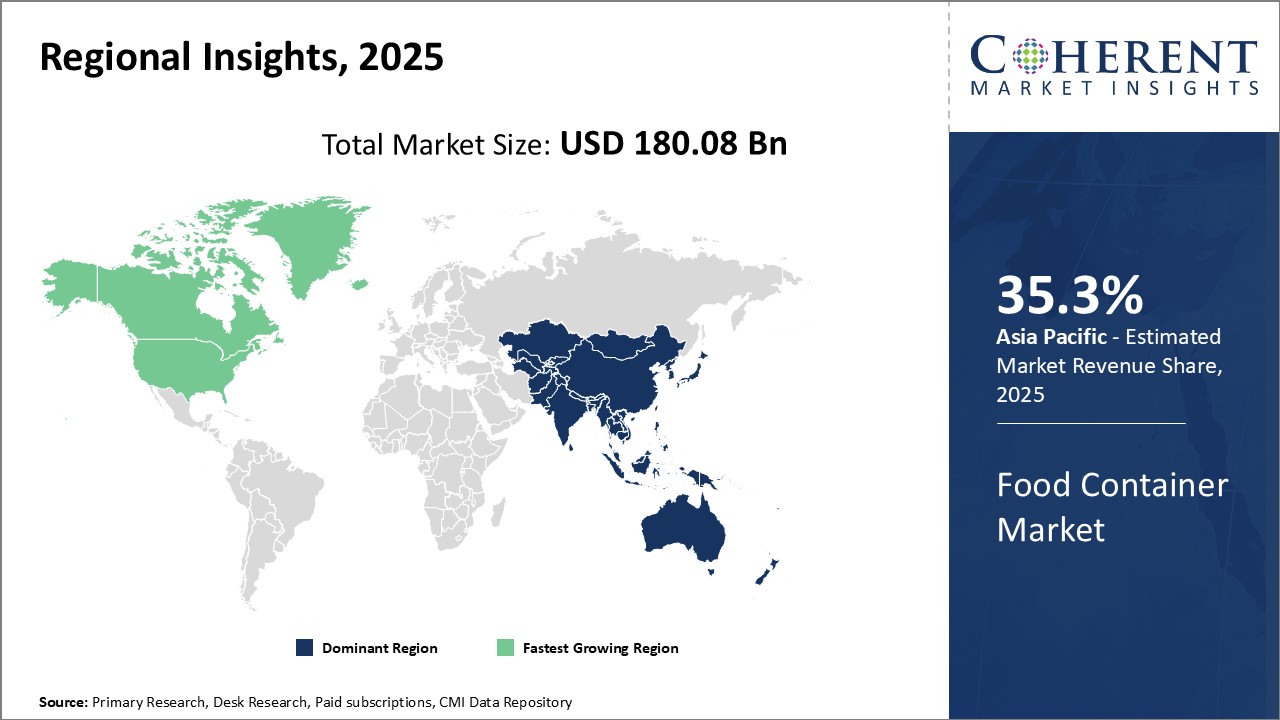
Need a Different Region or Segment? Download Free Sample
North America currently dominates the global food container market due to strong presence of major food container manufacturers in the region with 35.3% market share in 2025. Countries like U.S> and Canada have a robust food packaging industry that supplies both domestic as well as international markets. The demand for packaged and ready-to-eat foods is high among consumers in North America owing to busy lifestyle. Moreover, the regulatory environment regarding food safety and quality packaging is well-developed here. This encourages established players to continue production from their U.S. and Canadian based facilities. Some key players from the region also have strong distribution network within North America as well as important export markets like Europe and Asia Pacific.
One of the fastest growing regional markets for food containers is Asia Pacific. Countries like Indonesia, the Philippines, Vietnam, and Malaysia have shown significant increase in demand over the past few years. With rising disposable incomes, changing dietary habits and growing population, the consumption of packaged foods is on the rise. The food processing industry has also expanded rapidly in these nations. Local manufacturers are improving their production capabilities and capacities to satisfy the domestic needs. At the same time, Southeast Asian nations have emerged as important export hubs for food products to other Asian economies and the Middle East. Their competitively lower manufacturing costs and proximity to large consumer markets have helped food container manufacturers from the region increase their footprint. The ASEAN collaboration has further accelerated cross-border trade of food items and related packaging within Southeast Asia.
Food Container Market Report Coverage
| Report Coverage | Details | ||
|---|---|---|---|
| Base Year: | 2024 | Market Size in 2025: | USD 180.08 Bn |
| Historical Data for: | 2020 To 2024 | Forecast Period: | 2025 To 2032 |
| Forecast Period 2025 to 2032 CAGR: | 4.5% | 2032 Value Projection: | USD 245.23 Bn |
| Geographies covered: |
|
||
| Segments covered: |
|
||
| Companies covered: |
Amcor plc, Silgan Holdings, Inc., Ardagh Group, Berry Plastics Corp., Plastipak Holdings, Inc., Sonoco Products Company, Graham Packaging Company, Inc., Weener Plastics, Ball Corp., Tetra Pak, Arafhat Plastics, Prithvi Polymer Industries Pvt. Ltd., weorex , Zaika Plastopacks, and Ambika Packaging |
||
| Growth Drivers: |
|
||
| Restraints & Challenges: |
|
||
Uncover macros and micros vetted on 75+ parameters: Get instant access to report
*Definition: The global food container market consists of companies that manufacture and sell containers used for packaging foods and beverages. This includes things like cans, bottles, jars, boxes, bags, and other types of packaging used across the food supply chain for containing products during production, storage, transportation, and sales. The food container market is massive as virtually every food product requires some form of packaging to reach consumers.
Share
Share
About Author
Pankaj Poddar is a seasoned market research consultant with over 12 years of extensive experience in the fast-moving consumer goods (FMCG) and plastics material industries. He holds a Master’s degree in Business Administration with specialization in Marketing from Nirma University, one of India’s reputed institutions, which has equipped him with a solid foundation in strategic marketing and consumer behavior.
As a Senior Consultant at CMI for the past three years, he has been instrumental in harnessing his comprehensive understanding of market dynamics to provide our clients with actionable insights and strategic guidance. Throughout his career, He has developed a robust expertise in several key areas, including market estimation, competitive analysis, and the identification of emerging industry trends. His approach is grounded in a commitment to understanding client needs thoroughly and fostering collaborative relationships. His dedication to excellence and innovation solidifies his role as a trusted advisor in the ever-evolving landscape of not only FMCG but also chemicals and materials markets.
Missing comfort of reading report in your local language? Find your preferred language :
Transform your Strategy with Exclusive Trending Reports :
Frequently Asked Questions
Joining thousands of companies around the world committed to making the Excellent Business Solutions.
View All Our Clients